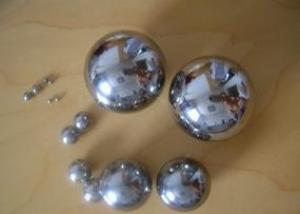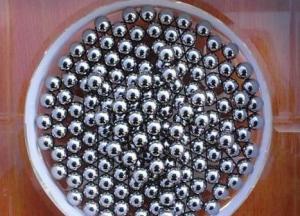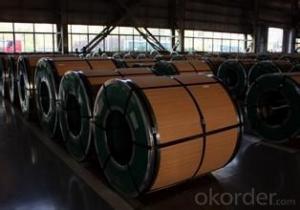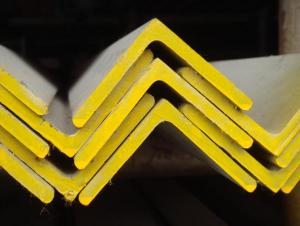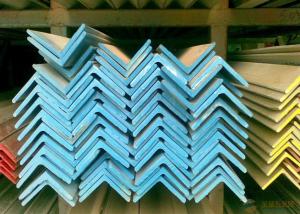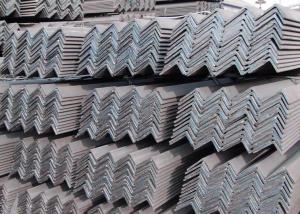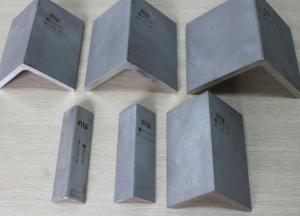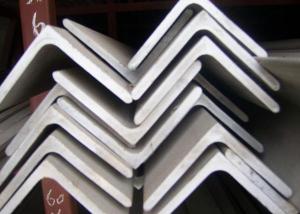Stainless steel angle; angle steel
- Loading Port:
- Guangzhou
- Payment Terms:
- TT OR LC
- Min Order Qty:
- 50 m.t.
- Supply Capability:
- 10000 m.t./month
OKorder Service Pledge
OKorder Financial Service
You Might Also Like
General Informaiton of Stainless Steel Angle Bar
1. Grade: SS200, 300,400 series
2. Size: 25×25×3 mm-100×100×10mm
3. Process: HRAP
4. Length: 2-6m
5. Shape: Equal
6. Delivery: within 20 days
7. MOQ: 1 ton
8. Certificate: ISO 9001:2008, SGS
9. Package: Standard Export Packing, or put into wooden boxes according to your requirement
10. Application: Construction, Marine, Industry etc.
Specification of Stainless Steel Angle Bar
Name | Stainless Steel Angles | |||||
Standard | ASTM A554, A312, A249, A269 and A270 | |||||
Material Grade | 304,316,201,202, 316L,430 | |||||
Length | 6m or as customers' request | |||||
Tolerance | a) Thickness: +/-0. 15mm | |||||
b) Length: +/-4. 5mm - 0mm | ||||||
Surface | 180G, 320G, 400G Satin / Hairline(Matt Finish, Brush, Dull Finish) 400G, 500G, 600G or 800G Mirror finish | |||||
Application | Decoration construction, upholstery, industry instruments | |||||
Test | Squash test, Extended test, Water pressure test, Crystal rot test, Heat treatment, NDT | |||||
Chemical Composition of Material | Composition Material | 201 | 202 | 304 | 316 | 430 |
C | ≤0.15 | ≤0.15 | ≤0.08 | ≤0.08 | ≤0.12 | |
Si | ≤1.00 | ≤1.00 | ≤1.00 | ≤1.00 | ≤1.00 | |
Mn | 5.5-7.5 | 7.5-10 | ≤2.00 | ≤2.00 | ≤1.00 | |
P | ≤0.06 | ≤0.06 | ≤0.045 | ≤0.045 | ≤0.040 | |
S | ≤0.03 | ≤0.03 | ≤0.030 | ≤0.030 | ≤0.030 | |
Cr | 16-18 | 17-19 | 18-20 | 16-18 | 16-18 | |
Ni | 3.5-5.5 | 4-6 | 8-10.5 | 10-14 | ||
Mo | 2.0-3.0 | |||||
Mechanical Property | Material Item | 201 | 202 | 304 | 316 | |
Tensile Strength | ≥535 | ≥520 | ≥520 | ≥520 | ||
Yield Strength | ≥245 | ≥205 | ≥205 | ≥205 | ||
Extension | ≥30% | ≥30% | ≥35% | ≥35% | ||
Hardness (HV) | <253 | <253 | <200 | <200 | ||
- Q:What are the different types of bending processes for stainless steel angles?
- There are several different types of bending processes that can be used for stainless steel angles. 1. Roll Bending: This process involves passing the stainless steel angle through a set of rollers to gradually bend it into the desired shape. Roll bending is commonly used for large-scale production and can achieve precise and consistent bends. 2. Press Brake Bending: In this method, a press brake machine is used to apply force to the stainless steel angle, causing it to bend. This process allows for greater control and flexibility in achieving different angles and shapes. 3. Induction Bending: Induction bending utilizes heat and force to bend the stainless steel angle. The angle is heated using an induction coil, and then pressure is applied to shape it into the desired form. Induction bending is often used for large and heavy stainless steel angles. 4. Rotary Draw Bending: This technique involves clamping the stainless steel angle into a machine and using rotating tools to gradually bend it. Rotary draw bending is known for its precision and is commonly used for small-scale production. 5. Mandrel Bending: Mandrel bending uses a mandrel or a flexible insert to support the inside of the stainless steel angle during the bending process. This ensures that the angle maintains its shape and integrity, especially when dealing with tight bends or small radii. Each bending process has its advantages and is suitable for different applications. The choice of the bending method will depend on factors such as the desired angle, the thickness of the stainless steel, production volume, and the required precision.
- Q:What are the different types of surface finishes for slotted stainless steel angles?
- Some of the different types of surface finishes for slotted stainless steel angles include brushed, mirror, satin, and mill finishes.
- Q:Can stainless steel angles be used in the production of kitchen equipment?
- Yes, stainless steel angles can be used in the production of kitchen equipment. Stainless steel is a popular choice for kitchen equipment due to its excellent corrosion resistance, durability, and aesthetic appeal. Stainless steel angles can be used to create the framework and structural support for various kitchen equipment such as shelves, tables, countertops, and cabinets. The angles provide stability and strength to the equipment, ensuring its longevity and ability to withstand heavy use in a kitchen environment. Additionally, stainless steel is easy to clean and maintain, making it a hygienic choice for kitchen equipment.
- Q:What is the difference between 304L and 316L stainless steel angles?
- The main difference between 304L and 316L stainless steel angles lies in their composition and corrosion resistance properties. 304L stainless steel is a low carbon variation of the 304 grade, which means it contains less carbon and is more resistant to sensitization (formation of chromium carbides at grain boundaries). This makes it suitable for welding and reduces the risk of intergranular corrosion. It also offers good corrosion resistance in most atmospheric conditions and mild chemical environments. On the other hand, 316L stainless steel is a low carbon variation of the 316 grade, which is commonly known as marine-grade stainless steel. It contains molybdenum, which enhances its corrosion resistance, especially against chlorides and other aggressive environments. 316L stainless steel is often used in marine applications, chemical processing plants, and medical equipment due to its superior resistance against pitting and crevice corrosion. In terms of their mechanical properties, both 304L and 316L stainless steel angles have excellent strength, toughness, and formability. However, 316L stainless steel is slightly stronger and more durable than 304L stainless steel. In summary, the choice between 304L and 316L stainless steel angles depends on the specific application and the desired level of corrosion resistance. If you are working in a marine or highly corrosive environment, 316L stainless steel angles would be the better choice. For general applications where corrosion resistance is not a primary concern, 304L stainless steel angles are a cost-effective option.
- Q:Can stainless steel angles be used in laboratory environments?
- Stainless steel angles are indeed applicable in laboratory settings. Due to its exceptional resistance to corrosion, stainless steel proves to be an excellent choice for environments that might entail exposure to chemicals or other corrosive elements commonly encountered in laboratories. Moreover, stainless steel angles exhibit remarkable durability and the ability to withstand substantial loads, rendering them appropriate for a range of uses including support structures, frames, and equipment mounting. Furthermore, stainless steel boasts effortless maintenance and cleaning, which is of utmost importance in laboratory environments where hygiene and sterility hold significant value.
- Q:Are stainless steel angles resistant to impact?
- Indeed, impact resistance is a characteristic that stainless steel angles possess. Renowned for its robustness and durability, stainless steel exhibits remarkable resistance to impact. Its composition, comprising of chromium and nickel, grants it outstanding corrosion resistance and toughness. Consequently, stainless steel angles prove to be ideal for numerous applications that demand impact resistance, including but not limited to construction, manufacturing, and the automotive industry. Furthermore, stainless steel angles can endure substantial loads and harsh weather conditions, thereby amplifying their impact resistance.
- Q:How do you prevent rust on stainless steel angles?
- One effective way to prevent rust on stainless steel angles is by regular cleaning and maintenance. This involves removing any dirt or debris from the surface of the angles and ensuring they are completely dry. Additionally, applying a protective coating, such as a passivation treatment or a corrosion-resistant paint, can help create a barrier against moisture and other corrosive elements.
- Q:Are stainless steel angles suitable for the production of street signs?
- Stainless steel angles are indeed a great choice for making street signs. With their durability and resistance to corrosion, they can easily withstand the harshest weather conditions and the wear and tear of outdoor environments. By utilizing stainless steel angles, we can ensure that the street signs are not only robust and steady, but also capable of enduring impacts and remaining in place for an extended period. Furthermore, stainless steel is incredibly effortless to clean and maintain, which is of utmost importance in keeping the street signs visible and legible. All in all, stainless steel angles are an extremely dependable option for producing street signs due to their long-lasting nature, ability to resist corrosion, and minimal maintenance requirements.
- Q:Can stainless steel be ground?
- No, because the conductivity of stainless steel is very low, lower than iron, not to mention the general metal for good conductors, such as copper and aluminum. (the conductivity meter of metal is over here. There is a need. Please search it at Niang)
- Q:How do you calculate the section modulus for a slotted stainless steel angle?
- To calculate the section modulus for a slotted stainless steel angle, you would need to first determine the moment of inertia of the section. The moment of inertia is a measure of an object's resistance to changes in its rotation, and it can be calculated using the dimensions and shape of the object. For a slotted stainless steel angle, you would need to know the dimensions of the angle, including the length of each leg and the thickness of the angle. Once you have these dimensions, you can use the appropriate formula to calculate the moment of inertia for the section. The moment of inertia is calculated differently depending on the shape of the section. For a slotted angle, the moment of inertia can be calculated as the sum of the individual moment of inertia for each part of the section. This means that you would need to calculate the moment of inertia for each leg of the angle and the slot separately, and then add them together. Once you have calculated the moment of inertia for the slotted stainless steel angle, you can use this value to calculate the section modulus. The section modulus is a measure of the resistance of a section to bending and is calculated by dividing the moment of inertia by the distance from the neutral axis to the outermost fiber of the section. The section modulus is an important parameter in structural engineering as it helps determine the strength and stiffness of a section. It is often used in the design of beams and other structural members to ensure that they can withstand the loads they will be subjected to. In summary, to calculate the section modulus for a slotted stainless steel angle, you would need to calculate the moment of inertia for each part of the section, including the legs and the slot, and then sum them together. This moment of inertia can then be used to calculate the section modulus, which is an important parameter in structural engineering.
1. Manufacturer Overview |
|
|---|---|
| Location | |
| Year Established | |
| Annual Output Value | |
| Main Markets | |
| Company Certifications | |
2. Manufacturer Certificates |
|
|---|---|
| a) Certification Name | |
| Range | |
| Reference | |
| Validity Period | |
3. Manufacturer Capability |
|
|---|---|
| a)Trade Capacity | |
| Nearest Port | |
| Export Percentage | |
| No.of Employees in Trade Department | |
| Language Spoken: | |
| b)Factory Information | |
| Factory Size: | |
| No. of Production Lines | |
| Contract Manufacturing | |
| Product Price Range | |
Send your message to us
Stainless steel angle; angle steel
- Loading Port:
- Guangzhou
- Payment Terms:
- TT OR LC
- Min Order Qty:
- 50 m.t.
- Supply Capability:
- 10000 m.t./month
OKorder Service Pledge
OKorder Financial Service
Similar products
New products
Hot products
Related keywords








